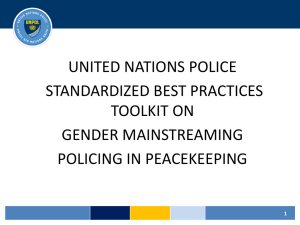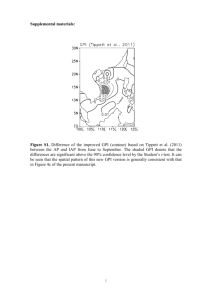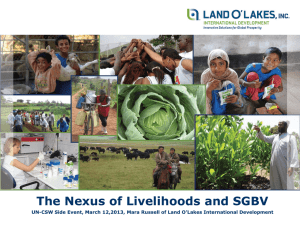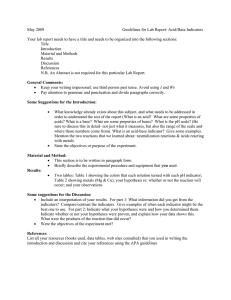Gender disparities in refugee contexts: Case studies using health indicators
advertisement
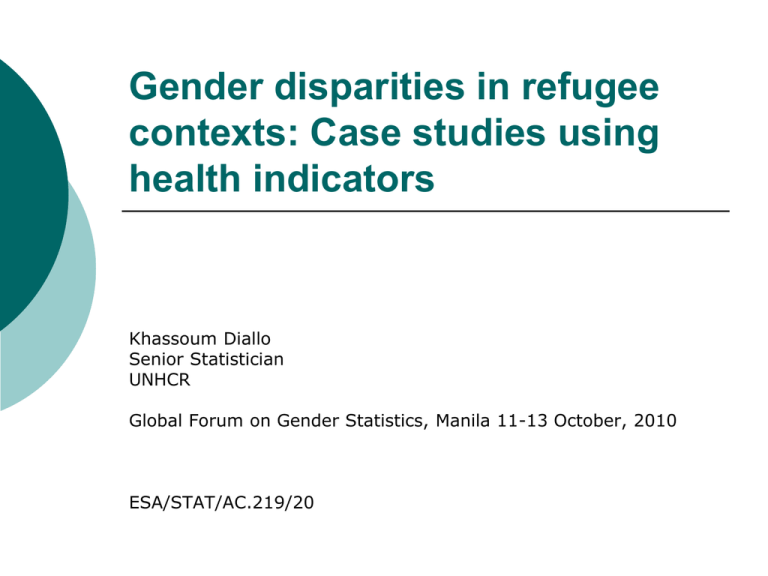
Gender disparities in refugee contexts: Case studies using health indicators Khassoum Diallo Senior Statistician UNHCR Global Forum on Gender Statistics, Manila 11-13 October, 2010 ESA/STAT/AC.219/20 SCOPE OF FORCED DISPLACEMENT Forcibly displaced persons represent a significant share of the de facto population of many countries Share of displaced population vs total population, end 2009 Syria Refugees and Asylum-seekers ~ 16 million end-2009. Internally Displaced People (27 million) Daddab refugee camp (300,000 people): 4th city of Kenya does not appear in any official statistics or map of Kenya In many countries, MDGs or other international goals cannot be achieved without addressing the needs of populations affected by conflicts and emergencies, especially women and children 5% Jordan 8% Colombia 10% Afghanistan 0% 12% 2% 4% 6% 8% 10% 12% 2 Demographic patterns Increasing share of urban refugees (close to 60% in 2009 Between 70-90% of refugees remain in their region of origin Age & sex distribution Female Category Male 0-4yrs 5-11yrs 12-17yrs 18-59yrs 60yrs+ 0-4yrs 5-11yrs 12-17yrs 18-59yrs 60yrs+ R+AS 5% 9% 7% 24% 2% 5% 10% 8% 27% 2% IDPs 5% 9% 7% 26% 3% 5% 10% 7% 26% 3% RET 9% 12% 7% 19% 2% 9% 13% 8% 19% 2% RDP 11% 13% 6% 25% 1% 10% 10% 6% 17% 1% 3 Data Sources & methods UNHCR’s Health Information System The Standards and Indicators Programme (over 100 countries, by location) Participatory assessments (over 120 countries, at least once every year) Routine registration and monitoring system from Governments & other partners Mix of sources (surveys, censuses, estimation methods etc.) Data quality assessment and triangulation 4 Health Information System Core health topics: Mortality, morbidity, RH, Nutrition, Access to 5 services Relationships Conflict Displacement Health Gender related issues: Women, men, boys and girls impacted differently • Gender based violence (e.g. rape, domestic violence) • Reproductive/including maternal health • Access to health services 6 Analyses/ Presentation Methods Gap and Trends analyses Scorecards Indices: Composite indices, including the gender parity index 7 Illustration using selected indicators Access to services Women’s empowerment Gender based violence HIV Testing and Counseling 8 Access and use of health facilities % of deliveries at health centers, 2009 Zambia Yemen Uganda Thailand Tanzania Sudan Rw anda Nepal Kenya Ethiopia Djibouti Chad Cameroon Burundi Bangladesh 0% 10% 20% 30% 40% 50% 60% 70% 80% 90% 100% 9 Women’s participation in decision making Percentage of camps w hich meet the standard of minimum 50% female members in food distribution committees Camp Indicator Standard not met Less than 45% involved in distribution are w omen Standard almost met 45-50% involved in distribution are w omen Standard Met More than 50% involved in distribution are w omen 10 VCT: Tested for HIV VCT: Tested for HIV refugees > 18 years female male 100% 90% 80% 60% 50% 40% 30% 20% 10% Ug an da Rw an da Bu ru nd i Dj ibo ut i Ye m en bia Za m Ke ny a Su da n Ch ad Ne pa l Gu in ea 0% Ta nz an ia % by sex 70% 11 Measuring performance in health CRITERIA INDICATOR - CAMP No. of camps STANDARD ALMOST MET Yes NOT MET No Does your office have a Standard Operating Procedure (SOP) for SGBV? % of Camps % % % Standa Stan Standar rd dard d not almost Met met met 89 92% 75 88% 3% 9% 64 97% 2% 2% 90 23% 6% 71% 81 77% 1% 22% Percentage of food beneficiaries entitled to food who received food during latest food distribution 82 71% 23% 6% <2,000 Average number of kilocalories available per person per day 84 48% 6% 46% 45-49% <45% Percentage of female members in food distribution committees 10,001-12,000 >12000 Min 50% 40-49% <40% Max 15% 15-20% >20% Min 90% 80-89% <80% 100% 90-99% <90% 100% 90-99% <90% Min 10% 7-10% <7% Min 10% 7-10% <7% 100% 90-99% <90% Min 2,100 2,001-2,001 Min 50% Max 10,000 No Yes Percentage of SGBV cases who received support (DP) Percentage of SGBV cases <18 years old who received support (DP) Percentage of asylum-seekers / refugees who participated in SGBV training Percentage of UNHCR and partner staff who have completed SGBV training No. of persons per primary health care facility Percentage of live births attended by skilled personnel (excl. TBAs) Percentage of newborn children with low birth weight (< 2500 gs) (weighed within 72 hrs) Measles vaccination coverage Have stocks of condoms run out for more than a week? 8% 76 68% 4% 28% 138 52% 7% 41% 128 62% 2% 36% 122 97% 1% 2% 95 64% 17% 19% 90 69% 103 57% 9% 34% 31% Min 20 L. 18-19 L <18 L Average quantity of water available per person per day (litres) Max 80 81-100 >100 No. of persons per usable water tap 82 52% 12% 35% Max 200 201-250 >250 No. of persons per usable well/hand pump 59 51% 7% 42% 100% 90-99% <90% Percentage of pop. living within 200 m from water point 98 55% 11% 34% 12 Gender Parity Index (GPI) Gender parity index (GPI) 2009 (Ordered) GPI Definition Ratio of female to male values of a given indicator. A GPI of 1 indicates parity between sexes. The gender parity index (GPI): ratio between the female and the male rates (F/M), where: GPI below 1 means disparity in favor of boys/men GPI = 1 means parity (the male and female indicators are equal) GPI above 1 means disparity in favor of girls or Indicator Percentage of UNHCR and partner staff w ho have completed SGBV training (RET) Percentage of UNHCR and partner staff w ho have completed SGBV training (CMP) Percentage of SGBV cases w ho received support (URB) Percentage of SGBV cases w ho received support (RET) GPI Female Male (Gender Denominat Female Female Denominat Male Male Parity or Numerator Indicator or Numerator Indicator Index F/M) 678 400 59.0% 1,160 435 37.5% 1.57 2,981 799 26.8% 6,577 1,528 23.2% 1.15 2,190 1,733 79.1% 147 110 74.8% 1.06 682 542 79.5% 69 68 98.6% 0.81 13 In conclusion: Lessons learnt from gender analyses Gender disparities remain high for many health-related indicators in a number of refugee contexts Difficult to analyze most of maternal health indicators from a gender perspective Data collection and quality remain a challenge Post analysis phase: translation of findings 14
